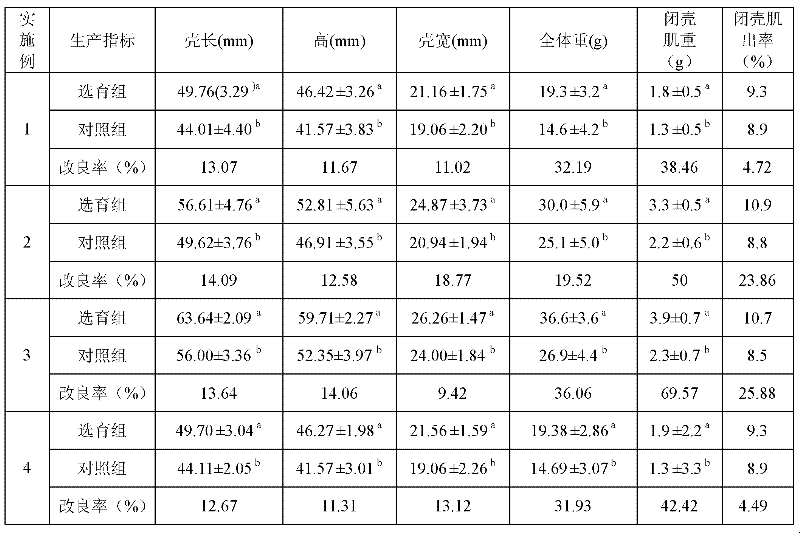Contemporary multipoint composite breeding method for bay scallop
A technology of bay scallops and scallops, applied in the field of multi-point compound breeding of the same generation of bay scallops, can solve the problems of low breeding efficiency, easy decline in genetic diversity of breeding populations, low breeding intensity, etc., to avoid genetic drift Mutation and genetic diversity decline, speed up the selection of breeding, improve the effect of efficiency
- Summary
- Abstract
- Description
- Claims
- Application Information
AI Technical Summary
Problems solved by technology
Method used
Image
Examples
Embodiment 1
[0019] After the bay scallop spawns, the water temperature of the nursery pond for cultivating planktonic larvae is controlled at 22-24 degrees Celsius, the ammonia state does not exceed 200 mg / m3, the light is below 500 lux, continuous or intermittent aeration, and the dissolved oxygen is not less than 5 mg / m3 liters, the pH value is 7.9-8.2, and the COD is not higher than 2 mg / liter. The larvae are mainly fed with golden algae in the early stage, and the culture density is not more than 10 / ml at the beginning, and the density of larvae in the later stage is 5-7 / ml. In the later stage, the mixed bait of flat algae and golden algae is the main bait, and the mixing ratio is generally 1:1 by volume. When 1 / 3 of the seedlings in the nursery pond have eyespots, the attachment substrate is put in. As the larvae grow out of secondary shells and develop metamorphosis The bait was changed to a mixed bait of diatoms and flat algae (the ratio of feeding and feeding was 1:1 by volume), a...
Embodiment 2
[0024]After the bay scallop spawns, the water temperature of the nursery pond for cultivating planktonic larvae is controlled at 22-24 degrees Celsius, the ammonia state does not exceed 200 mg / m3, the light is below 500 lux, continuous or intermittent aeration, and the dissolved oxygen is not less than 5 mg / m3 liters, the pH value is 7.9-8.2, and the COD is not higher than 2 mg / liter. The culture density was not more than 10 / ml at the beginning, and the density of vegae larvae was 5-7 / ml in the later stage. The larvae are mainly fed with golden algae in the early stage, and the mixed bait of flat algae and golden algae in the later stage, and the mixing ratio is generally 1:1 by volume. Add appropriate amount of diatoms to the metamorphosis stage and observe the larvae's stomach under the microscope every day to determine the number and amount of bait feeding (specifically, in general, feed four times a day, the daily feeding amount is 10,000 cells / ml, observe the larvae's sto...
PUM
 Login to View More
Login to View More Abstract
Description
Claims
Application Information
 Login to View More
Login to View More - R&D Engineer
- R&D Manager
- IP Professional
- Industry Leading Data Capabilities
- Powerful AI technology
- Patent DNA Extraction
Browse by: Latest US Patents, China's latest patents, Technical Efficacy Thesaurus, Application Domain, Technology Topic, Popular Technical Reports.
© 2024 PatSnap. All rights reserved.Legal|Privacy policy|Modern Slavery Act Transparency Statement|Sitemap|About US| Contact US: help@patsnap.com








